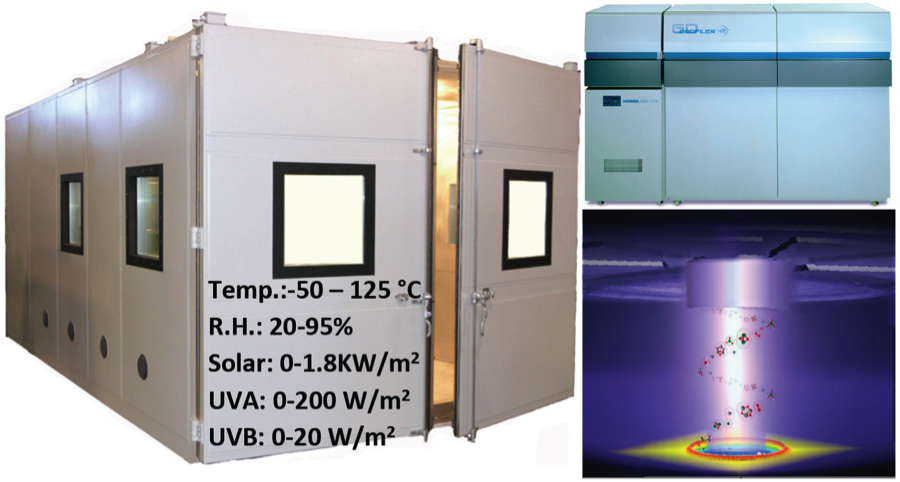| |
Title |
| |
|
DURIP – Multifunctional Weathering System for Life Cycle Performance Investigation of Emerging Polymer Materials and Structures
|
| |
| |
Participants |
| |
|
- Huiming Yin
- Rene B. Testa
- Raimondo Betti
- Maria Q. Feng
- Adrian Brügger
|
| |
Project Quad |
| |
|

|
| |
| |
Summary/Objectives |
| |
|
The objective of this DURIP program is to develop and install a multifunctional weathering system to create extreme environments for materials testing and to reproduce service environments for development and validation of emerging defense structural components for their life cycle performance. To this end, a water chiller is requested for the cooling and humidity
control of the environmental chamber; a dynamic servo-hydraulic controller for the in-situ mechanical tests under weathering conditions; and a glow discharge system high resolution profiler for depth profiling of materials under aging process. The instruments proposed will be integrated into the existing facilities in the Carleton Laboratory and will immediately create research capabilities on development and characterization of new defense materials and structural components. This instrumentation system will apply not only to lifetime sustainability of common polymer materials, but to the development of a wide range of emerging advanced materials and components in defense applications, such as smart helmets and body armors, protective coatings of naval structural, and building envelope materials for solar energy. The research and testing that will be conducted with this versatile instrumentation system will range from nano to macro scale, and from the theoretical to the empirical. The success of this project will greatly enhance our research in materials engineering and accelerated testing. This large sized instrument will be a unique resource for a broad interdisciplinary community, both within Columbia University and throughout the region, capable of studying effects at the material and the larger structural levels. The development will integrate state-ofthe-art research in materials science, experimental mechanics, smart sensing, thermo-physics, and industrial technology towards a novel multifunctional weathering system, which will enhance our research and education infrastructure for training the next generation engineers and researchers and produce broad impacts on research and research-related education areas in materials, energy, and environmental engineering.
|
| |
| |
Method |
| |
|
1. Simulate climatic environment to promote solar energy utilization
|
| |
|
- This environmental chamber will reproduce stable sunlight in the laboratory and thus significantly expedite the solar panel development.
- This chamber can simulate different weather conditions and provide in-service data for new solar panels, so that an optimal product design can be obtained for different areas.
- This instrument will accelerate the aging tests to predict the long-term performance and estimate the warranty of new solar roofing panels. Using this chamber, the energy production, environmental impact and life-cycle cost of a solar panel with polymer materials can be accurately quantified and compared with other alternatives for different weather conditions.
|
| |
|
2. Reveal thermo-mechanical behavior of materials under different levels of aging conditions |
| |
|
- Using time-temperature superposition, time-degradation superposition, and time-stress superposition to calibrate the parameters and predict the long-term performance of the material with short-term tests.
|
| |
|
3. Measure the energy and environmental impact of infrastructure in production and service |
| |
|
- Measure and Control the mass and heat transfer through the chamber can be quantitatively measured and controlled. Through chemical analysis of the air and water flow samples to characterize the waste production and emissions.
- Provide relevant operational space for sustainable material production, structure aging tests, and service loading test.
- Monitor the energy consumption and gas emissions.
- Through accelerated aging test with this instrument to obtain the lifetime energy consumption and environmental impact of WMA.
|
| |
|
4. Catalyze next generation of design methods and technologies of green construction |
| |
|
- Using life-cycle assessment (LCA) and life-cycle cost (LCC) methods to address economic, environmental and social aspects of sustainability and minimize the risks of infrastructure under extreme work conditions.
|
| |
Results |
| |
|
- Installation of cooling and humidity control of the chamber is underway
- A glow discharge high resolution profiler has been ordered and will be delivered in 2013
- Long term performance of epoxy adhesive anchor system demonstrates the time-temperature superposition principle
- The system provides test beds for developing accelerated test protocols
|
| |

